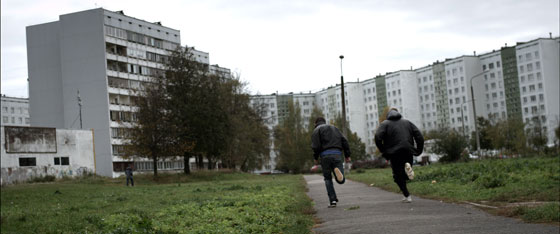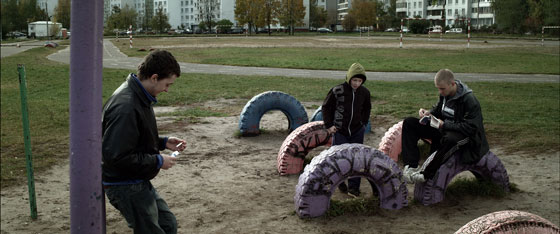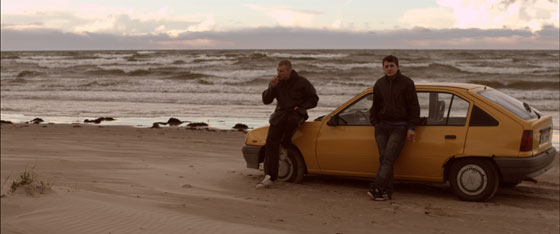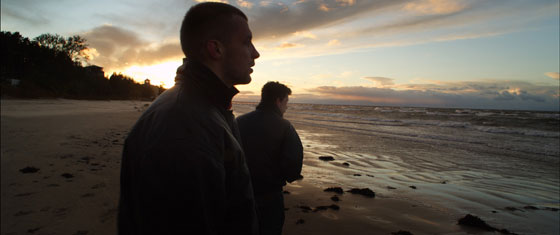|
|
| The alien and your own. The neighbourhood Sonora Broka, Film Theorist | |
| While Latvian cinema hasn’t yet become bogged down in heroic sagas and musical productions, I’d recommend that you head to cinema theatres to see a Riga that’s outside your usual daily itinerary in Aik Karapetian’s film Cilvēki tur (‘People There’). It’s paradoxical that director Karapetian, who in interviews has consistently spoken negatively about auteur cinema which one encounters only at film festivals, has himself created a classic European festival film. ‘People There’ has been made according to the best examples of the genre, and is not without some influence from a year studying to be a director at a Parisian cinema school. The year 2012 has begun with conflicting emotions. There’s been joy about a long awaited influx of drama films. In the media, passions surrounding Juris Poškus’ Kolka Cool still haven’t died down and already a new furore has brewed up parallel – about Aik Karapetian’s debut feature-length drama ‘People There’. The long awaited and finally released Golfa straume zem ledus kalna (‘Gulf Stream under a Mountain of Ice’) by Yevgeny Pashkevich and ‘Mona’ by Ināra Kolmane had their premieres as part of Latvia’s Film Festival Lielais Kristaps [Latvia’s “Oscars”]. A long shadow was cast over these cinema events, major on a local scale, by the idea of national commissioning as proposed by politicians. Many years ago, when Russian documentary maker Marina Razbezhkina visited Riga, I listened to her stories incredulously about how a support programme for patriotic cinema had been established in Russia, and thought to myself how good it was that nothing similar could ever happen in Latvia... | |
 Still from Aiks Karapetjans' movie People There. 2012 Photo from the Locomotive film studio archive | |
| The unattractive everyday life of the residents of a micro-district [Soviet high-rise housing estate] or dormitory suburb is such an ideal theme for cinema that it is surprising how late Latvians have received their first real so-called neighbourhood film. France, Great Britain, Germany, and also Denmark and other EU countries have already understood the international topicality of this genre. Moreover, it’s not important whether as the basis of the story there is ethnic, class, religious or any other kind of conflict, this kind of film can be seen at every film festival, though, it is true, it features more rarely in the regular repertoire of mainstream cinema theatres. From the array of “neighbourhood films” seen in Latvia in the past year, Andrea Arnold’s Fish Tank (Great Britain, 2009), Omar Shargawi’s Go with Peace Jamil (Denmark, 2008), and Lorna’s Silence by the brothers Jean-Pierre and Luc Dardenne (Belgium, France, 2008) all come to mind. The universality of the People There story, without being attached to any specific place, in this case Riga, as if opens the way to a wider international audience, but at the same time places it among a whole string of similar films. The use of national traits – be they language, architecture, traditions or the cultural environment – doesn’t necessarily condemn the product (the film) to an early death. A few examples. In the 2006 film by Danish director Annette K. Olesen 1:1 (a story about a contemporary Romeo / Shadi and Juliette / Mie), immediately after the opening credits a simple, but very successful and easily understood illustrative technique is used: we see drawings of a housing estate and hear that the estate has been designed for idyllic side by side co-existence between various Danish ethnic groups. But the contemporary reality cannot quite be called an idyll, when the love between the Muslim lad and the blonde Danish girl Mia is subjected to insurmountable obstacles. This is because of a savage attack by the lad’s countrymen, and possibly his brother, on Mia’s brother, very nearly causing his death. Whereas the action in the film C’est déjà l’été (‘Already Summer’, 2010), by Belgian director Martijn Smits takes place in a small coal mining town. Only the local residents, non-professional actors, can be seen in the film. Smits relies on the capacity of viewers to adapt the story to their own familiar places and situations. During the Breughel-like pub scene, when toothless drunks and over-intoxicated, tastelessly rouged up ladies start dancing, one can almost smell the reek of Belgian beer in the auditorium, but this didn’t stop the international audience at the film’s premiere at Rotterdam film festival giving it an ovation. | |
 Still from Aiks Karapetjans' movie People There. 2012 Photo from the Locomotive film studio archive | |
| Whereas the Latvian and Russian ethnic conflict sketched out in the film People There is almost the only reference to the fact that the film is taking place in Latvia. Possibly it’s not the microdistrict that is the main “hero” of the film. Still, seeing the heartfelt aerial shots of the estate, it becomes clear that, even without using the city square surrounding the Freedom Monument or the Ethnographic Open-Air Museum as the location for filming, Aik Karapetian hasn’t sought to reproduce an absolutely impersonal environment, rather he has merely foregone paying dues to the national aspect. Although immediately after watching the film a sacrilegious thought didn’t leave me that this could, possibly, be the most effective Latvian tourism film of all time. In a big city too, a Latvian contrives to live as if he were in an individual homestead. A Latvian carries his homestead with him, hidden deep within his heart. Therefore I will dare to assert that, from a Latvian’s perspective, People There is something exotic. This is a film in which the dormitory suburb in the protagonists’ lives is something more than a place to sleep, and from which to quickly hurry away again in the morning. The housing estate is their mother, their prison guard, their destiny. The cluster of grey, decaying buildings like a huge shell creates a closed environment, in which bored idlers unhurriedly lead their days in the hope that one day they will find that stroke of luck lying just around the corner, dropping out of a waste pipe, and meanwhile try their hand at petty thefts, which like a snow ball rolling downhill become increasingly larger and more serious. Jans and his friends are willing hostages to their environment, and this is a rarely seen angle, as opposed to the approved approach where the hero takes a deep breath and heads out into the unknown. It is natural that in those scenes when the borders of the housing estate are actually breached, the heroes of the film become vulnerable. The contrasting impersonality of the environment can be felt almost physically, an agitation in the scenes in the city centre and a chilling coldness in the new, luxurious apartment houses of the quiet centre, where “the affluent faction” live. The heart lives in the housing estate, but in the centre – is it money? | |
 Still from Aiks Karapetjans' movie People There. 2012 Photo from the Locomotive film studio archive | |
| The main hero of People There reminds me of a sort of Pinocchio or cousin of “Tim the Famous Little Duck”. This weakwilled, unmotivated anything from this, because he’s already embroiled in some new strife. One begins to wonder – is Jans really the hero of the film? The title implies: it’s film about people THERE. Does the environment in which we live truly have a determining role in the process of forming personality? A microdistrict is an artificially created residential complex, built in nowhere land, often as a set of temporary buildings with a 30 year expiry date, meant for a workforce arriving from the “brotherly republics”. The history of the microdistrict is all too short, and is mainly a story about “what was here before”. The choice isn’t huge: pastureland, green meadows or sand dunes which used to be great for skiing in winter. The young people in the film at times remind one of puppets, who operate within a kind of enclosed polygon dictated by primitive desires and instincts, following the opportunities for amusement provided by the estate: brawls and gambling bars. It’s a generation without a history – and it’s not without reason that we don’t get introduced to their families (except for Jans’ grandfather, who is quite a sad exception, however, as their relationship is on the borderline of catastrophe) – and obviously without a future. It’s a generation with a 30-year “use by” date. All the more striking, therefore, is the episode which is free from all of the conceptual layers pertaining to a city environment – the scene with the swim in the sea. Although one cannot fail to agree with those reviewers who interpret this episode as a tribute to the classics of cinema, the swim has its own, sovereign, deeply symbolic value. It is like a cleansing before the high point in the plotline – before Jans ridicules his dream, and before his friend Krekers points a weapon at him. Wading into the sea and coming into contact with primal forces, they experience a kind of purification, a return to childhood or the original point of departure. The swim is the moment of catharsis in the film. The culmination, arising from the story line, which follows in the beach house is like a logical but optional continuation, and only serves to remind us once again of the psychological differences between the two protagonists: Jans is an uninterrupted process type, who doesn’t even really know what to do when he’s achieved what he desired, but for his friend the essential thing is a resolution of the situation, which defuses the constantly growing psychological tension in their relationship. And then, at the moment when it seems the film has already stopped two times to look from a distance at what is happening, like a regurgitation of the swimming episode there follows the final scene, when it becomes clear that it cannot be final in the traditional meaning. Although he is capable of feeling, if only for just a fleeting moment, Jans exists in the process and not at its stopping off points. | |
 Still from Aiks Karapetjans' movie People There. 2012 Photo from the Locomotive film studio archive | |
| Even though we now can as if officially unveil a new genre in Latvian cinema, ‘People There’ doesn’t remain within the bounds of the “neighbourhood” genre alone, it also displays elements of coming-of-age films. At the beginning of the film Jans and his friends are characterized by an infantile perception of life, a deformed scale of values and a lack of motivation. Following the rules of the coming-of-age – the “growing up” genre – Jans and Krekers go through an initiation, going through various trials together, in this case a certain accumulation of criminal activities. While in terms of audience numbers People There has greatly exceeded the average attendance indicators for Latvian films at cinema theatres, we can begin to look forwards to the premiere of Aik Karapetian’s low budget horror film, which is expected to come out in the autumn. /Translator into English: Uldis Brūns/ | |
| go back | |







